Managing CCRs
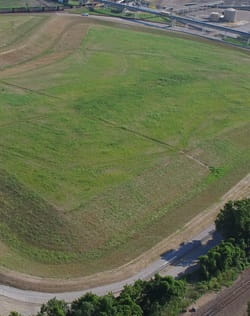
This ash basin at the Meramec Energy Center closed in the spring of 2018.
The Coal Combustion Residual (CCR) Rule contains technical standards for the design, operation and closure of landfills and basins located at coal-fired energy centers. Through this rule, EPA regulates CCR as solid waste under the Resource Conservation and Recovery Act (RCRA). RCRA requires that CCR facilities operate in a manner that presents "no reasonable probability of adverse effect on health or the environment."
Ameren Missouri has moved forward with an aggressive schedule to close its ash basins. Extensive monitoring networks have been installed at the energy centers. Groundwater impacts from historical usage of coal are limited to areas near the ash basins. These localized impacts do not present a risk to the public.
Expert-led investigations over many years definitively prove the basins do not impact public drinking water, private wells, or the Meramec, Mississippi and Missouri Rivers. There is no risk to the public from these ash basins.
Closure Update
Summer 2022 Update
Ameren Missouri completed the closure of all basins at two of its facilities in 2021 and has made significant progress by closing several impoundments at its other two facilities. Ameren Missouri plans to complete the closures of the remaining surface impoundments by 2024.
At Rush Island, the company continues to make progress after a successful pilot test of the treatment system. Full-scale implementation of this industry-leading technology is now complete at Rush Island, and efforts are underway to expand the treatment to the company's other energy centers. The work is permitted by the Missouri Department of Natural Resources, and they are being informed every step of the way. Data from 96% of the monitoring wells shows groundwater is meeting standards. Sophisticated modeling shows the basins can be closed and meet groundwater standards through corrective action measures, including the treatment system, decades earlier than excavation could be complete.
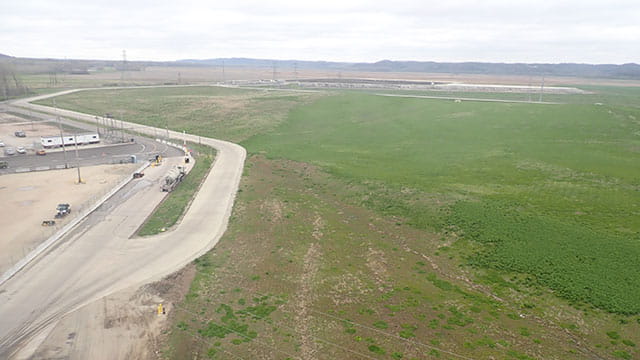
A closed basin at Labadie Energy Center.
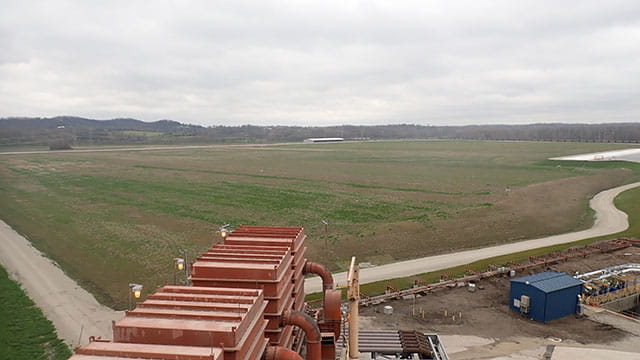
Between 2017 and 2021, Ameren recycled an average of 63% of CCRs for beneficial reuse.
Spring 2021 – Successful Groundwater Treatment
To address localized impact, Ameren Missouri is implementing treatment systems at its energy centers to remove trace metals from groundwater starting with Rush Island. Cutting-edge technology developed by environmental consultant XDD exceeds expectations to ensure clean water at the Rush Island Energy Center. Ameren Missouri recently installed groundwater treatment facilities there and can achieve 95%-99% reduction in concentrations of metals, including molybdenum and boron. Now, Ameren Missouri is moving forward at its other energy centers to provide another layer of protection for the environment.
After thorough testing in the lab by XDD and receiving a permit from MDNR, Ameren Missouri implemented the pilot project at the Rush Island Energy Center. The process included an above-ground treatment facility along with a series of on-site extraction and injection wells. The treatment process virtually eliminated all trace metals such as arsenic, boron, sulfate and molybdenum. Monthly sampling results from the system are submitted to MDNR.
Basin closure work is wrapping up at the Rush Island and Labadie energy centers and is set to be completed later this year at the Sioux Energy Center. To safely close the basins in the most efficient way possible while limiting impact on the communities Ameren Missouri serves and calls home, a nearly impermeable cap has been installed along with more than a foot of soil and clay, along with a protective top layer. It is contoured for controlled rainwater drainage.
Fall 2020 - Rapid Progress
Ameren Missouri is making rapid progress on safely closing ash basins at three of our four energy centers well ahead of regulatory requirements. Extensive construction activities have continued at all sites during the pandemic with construction schedules remaining largely intact. Crews can work safely while maintaining health protocols.
In 2019 alone, approximately 120 billion gallons of water was saved from coal plant and ash basin closures. Ameren Missouri is also recycling a majority of ash for beneficial use, primarily in cement and concrete production.
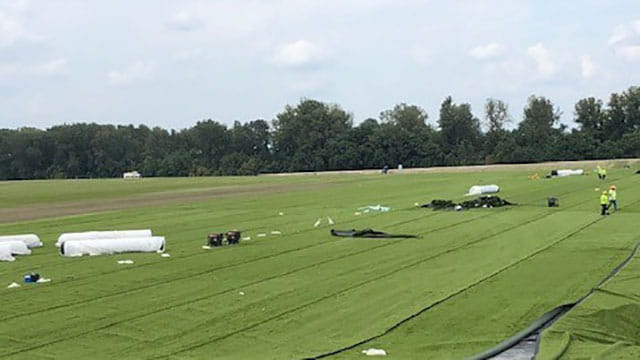
Crews finish covering the protective liner with turf and sand at Rush Island Energy Center. The cover is contoured for controlled rainwater drainage.
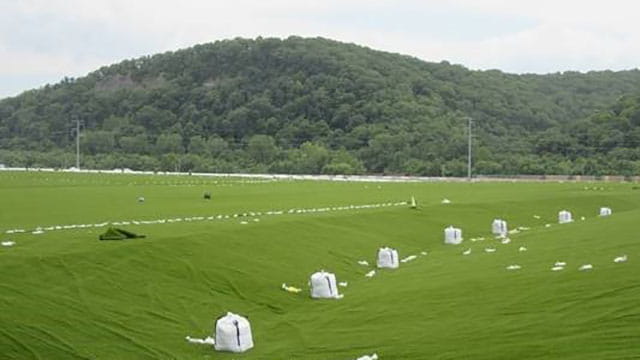
Weighted bags temporarily hold down the turf until sand is swept in, anchoring the turf to the liner below.
Our robust monitoring network consists of more than 250 wells around the four facilities. They track groundwater quality and measure water levels to help ensure the area continues to be protected. There continues to be no risk to public health and the environment. Extensive, expert-led reporting, stretching back to 2012, continues to demonstrate Ameren's safe handling of material. Those studies offer definitive proof that there is no off-site impact to drinking or surface water. In addition to our current network, we will be installing additional groundwater wells at Rush Island that will be used as part of an industry-leading groundwater treatment system pilot project. The Missouri Department of Natural Resources has given its preliminary approval, and the system will become operational once a final permit is issued later this year or early in 2021.
Construction updates include:
- A virtually impermeable protective liner is now installed over nearly all the basins.
- More than half of the installed liner is covered by a final top layer, either topsoil or turf.
- Recycling more than 70% of current ash production as a result of energy center upgrades.
Answers to Customer Questions
Ameren has been safely operating CCR storage facilities for decades. Below are answers to some frequently asked questions from the public about the comprehensive steps Ameren has taken to manage CCRs.What is Ameren doing to close the ash basins?
Ameren is implementing a comprehensive plan to safely and responsibly close ash basins that exceeds requirements created by the Obama Administration’s Environmental Protection Agency (EPA) in 2015. These EPA regulations require Ameren to close CCR basins and develop steps to address any impacts to groundwater in the communities where we work and live.
Basins can be closed by either placing a cover system over the top, or by excavating them by dredging out the material. The EPA has long maintained it does not have a preference on closure methods, both of which are effective in protecting the environment. The agency expects most CCR basins across the country will close via installation of a cover system. Ameren has thoroughly explored and used experts to help assist, on how to best design and close the basins and limit impacts on the communities we serve and call home. As a result of that extensive analysis, Ameren plans to close the basins by installing a cover system that exceeds regulatory requirements. Safe, responsible closure using this method is the most efficient path to achieve the groundwater protection standards set under the federal rule. Ameren Missouri's plans are summarized in the Remedy Selection Report (PDF).
What happens next?
Excess water is removed from the basins and the ash will be compacted, graded and sloped to permanently shed water. After that, an engineered capping system, far stronger than regulations require, will be constructed over the top of the basins and the riverside embankment walls armored with rock. This system will take approximately two years to construct and isolate the ash from infiltration. Precipitation will be routed to newly-constructed storm water basins. The limited groundwater impacts localized to Ameren property will diminish over time, and experts are evaluating methods to accelerate this process. Further details are available here.
Are there impacts on public health?
No. As demonstrated in numerous reports over many years, expert sampling results demonstrate that Ameren's CCR units do not impact public drinking water sources that draw from the Meramec, Mississippi and Missouri Rivers. Additional expert testing of groundwater used by drinking water wells near energy centers also show no impact.
Are CCR basins stable and safe?
Yes. Energy center personnel inspect the basins weekly and annual inspections are conducted by specially trained dam safety engineers. Because of their construction and design, the CCR basins at Ameren’s energy centers are in no danger of collapse, as has happened elsewhere. The basins have thick walls and are constructed to withstand up to an 8.0 magnitude earthquake. Even in cases of extreme flooding, as seen in the spring of 2019, the basins performed as designed.
What studies have been done?
For the past several years, Ameren has commissioned dozens of environmental studies by certified toxicologists and other experts in their fields of study. These ongoing inspections of groundwater, drinking and surface water conclude there is no risk to public health. Additional studies, posted to this website, looked at excavation and transportation issues associated with basin closure methods.
How has the community been involved in the process?
Ameren held four public meetings, one each near the four energy centers in May 2019. Attendees asked questions and left written comments. Additional comments were received via email. Ameren notified media outlets and posted information about the public meetings on this website.
More information is available under each section header at the top of this page, or in the public meeting and technical details response (PDF).
